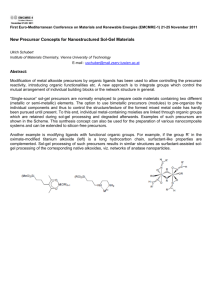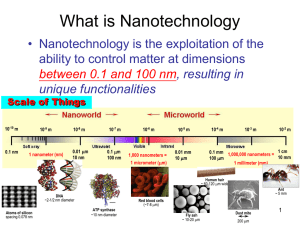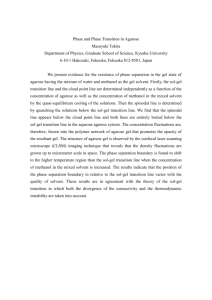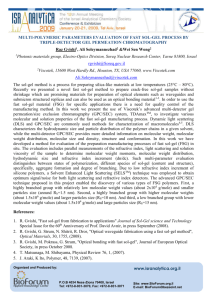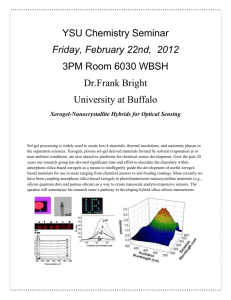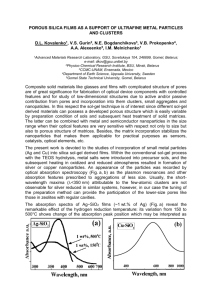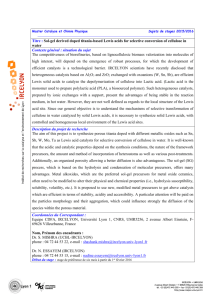Document 13359560
advertisement
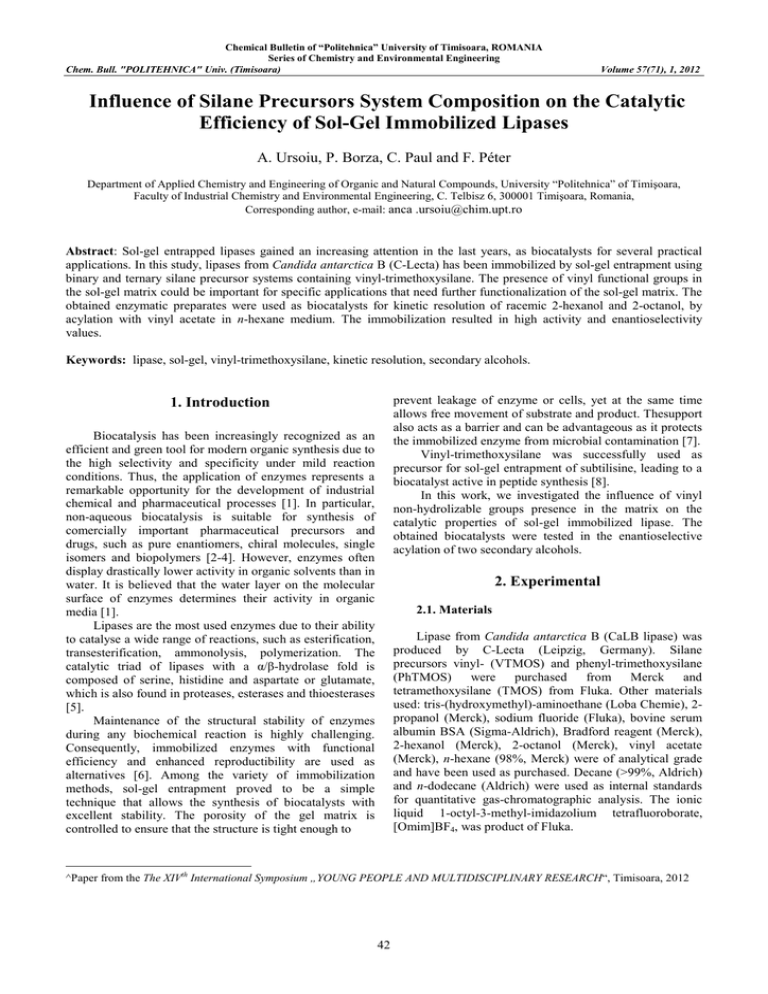
Chemical Bulletin of “Politehnica” University of Timisoara, ROMANIA Series of Chemistry and Environmental Engineering Chem. Bull. "POLITEHNICA" Univ. (Timisoara) 1 Volume 57(71), 1, 2012 Influence of Silane Precursors System Composition on the Catalytic Efficiency of Sol-Gel Immobilized Lipases A. Ursoiu, P. Borza, C. Paul and F. Péter Department of Applied Chemistry and Engineering of Organic and Natural Compounds, University “Politehnica” of Timişoara, Faculty of Industrial Chemistry and Environmental Engineering, C. Telbisz 6, 300001 Timişoara, Romania, Corresponding author, e-mail: anca .ursoiu@chim.upt.ro Abstract: Sol-gel entrapped lipases gained an increasing attention in the last years, as biocatalysts for several practical applications. In this study, lipases from Candida antarctica B (C-Lecta) has been immobilized by sol-gel entrapment using binary and ternary silane precursor systems containing vinyl-trimethoxysilane. The presence of vinyl functional groups in the sol-gel matrix could be important for specific applications that need further functionalization of the sol-gel matrix. The obtained enzymatic preparates were used as biocatalysts for kinetic resolution of racemic 2-hexanol and 2-octanol, by acylation with vinyl acetate in n-hexane medium. The immobilization resulted in high activity and enantioselectivity values. Keywords: lipase, sol-gel, vinyl-trimethoxysilane, kinetic resolution, secondary alcohols. prevent leakage of enzyme or cells, yet at the same time allows free movement of substrate and product. Thesupport also acts as a barrier and can be advantageous as it protects the immobilized enzyme from microbial contamination [7]. Vinyl-trimethoxysilane was successfully used as precursor for sol-gel entrapment of subtilisine, leading to a biocatalyst active in peptide synthesis [8]. In this work, we investigated the influence of vinyl non-hydrolizable groups presence in the matrix on the catalytic properties of sol-gel immobilized lipase. The obtained biocatalysts were tested in the enantioselective acylation of two secondary alcohols. 1. Introduction Biocatalysis has been increasingly recognized as an efficient and green tool for modern organic synthesis due to the high selectivity and specificity under mild reaction conditions. Thus, the application of enzymes represents a remarkable opportunity for the development of industrial chemical and pharmaceutical processes [1]. In particular, non-aqueous biocatalysis is suitable for synthesis of comercially important pharmaceutical precursors and drugs, such as pure enantiomers, chiral molecules, single isomers and biopolymers [2-4]. However, enzymes often display drastically lower activity in organic solvents than in water. It is believed that the water layer on the molecular surface of enzymes determines their activity in organic media [1]. Lipases are the most used enzymes due to their ability to catalyse a wide range of reactions, such as esterification, transesterification, ammonolysis, polymerization. The catalytic triad of lipases with a α/β-hydrolase fold is composed of serine, histidine and aspartate or glutamate, which is also found in proteases, esterases and thioesterases [5]. Maintenance of the structural stability of enzymes during any biochemical reaction is highly challenging. Consequently, immobilized enzymes with functional efficiency and enhanced reproductibility are used as alternatives [6]. Among the variety of immobilization methods, sol-gel entrapment proved to be a simple technique that allows the synthesis of biocatalysts with excellent stability. The porosity of the gel matrix is controlled to ensure that the structure is tight enough to 2. Experimental 2.1. Materials Lipase from Candida antarctica B (CaLB lipase) was produced by C-Lecta (Leipzig, Germany). Silane precursors vinyl- (VTMOS) and phenyl-trimethoxysilane (PhTMOS) were purchased from Merck and tetramethoxysilane (TMOS) from Fluka. Other materials used: tris-(hydroxymethyl)-aminoethane (Loba Chemie), 2propanol (Merck), sodium fluoride (Fluka), bovine serum albumin BSA (Sigma-Aldrich), Bradford reagent (Merck), 2-hexanol (Merck), 2-octanol (Merck), vinyl acetate (Merck), n-hexane (98%, Merck) were of analytical grade and have been used as purchased. Decane (>99%, Aldrich) and n-dodecane (Aldrich) were used as internal standards for quantitative gas-chromatographic analysis. The ionic liquid 1-octyl-3-methyl-imidazolium tetrafluoroborate, [Omim]BF4, was product of Fluka. ^Paper from the The XIVth International Symposium „YOUNG PEOPLE AND MULTIDISCIPLINARY RESEARCH“, Timisoara, 2012 42 Chem. Bull. "POLITEHNICA" Univ. (Timisoara) Volume 57(71), 1, 2012 excess of the resulted ester product (eep) was determined from peak areas of enantiomers, and the enantiomeric ratio (E) values were calculated based on conversion and e.ep values using the relation (1) [10]: 2.2. Immobilization by Sol-Gel Entrapment A microbial lipase suspension in TRIS/HCl 0.1 M, pH 8.0 buffer was stirred at room temperature for 30 min, centrifuged, and the supernatant used for immobilization. In a 4 mL glass vial, 1 mL of this lipase solution was mixed with 200 µL ionic liquid, followed by addition of 100 µL 1M NaF solution, and 200 µL isopropyl alcohol. This mixture was kept for 30 min under continuous stirring for homogenization, and subsequently a tertiary mixture of silane precursors (total 6 mmoles) was added. The mixture was stirred at room temperature until the gelation started. The obtained gel was kept for 24 h at room temperature to complete polymerization. The bulk gel was washed with isopropyl alcohol (7 mL), distilled water (5 mL), isopropyl alcohol again (5 mL) and finally n-hexane (5 mL), filtered, dried at room temperature for 24 h, and in a vacuum oven at room temperature for another 24 h. Finally, it was crushed in a mortar and kept in refrigerator. The amount of immobilized lipase was determined by measuring the protein content of free enzyme and washing solutions. The protein content was determined using the method developed by Bradford [9]. The immobilization yield was calculated as percentage of encapsulated protein and protein subjected to immobilization. The determined protein content of native lipase was 0.11 mg/mg. E= ln[1 − C (1 + eeP )] ln[1 − C (1 − eeP )] (1) where C represent the conversion at 24 h. All reactions have been run in duplicate and sampling was also made in duplicate. As the differences between the data for the same assay were less than 2%, average values have been calculated and presented in tables and figures. 3. Results and Discussion Immobilization conditions and the composition of silane precursors system are essential for the final properties of the immobilized biocatalyst. The properties and morphology of the final materials can be easily tuned by the appropriate chose of the silane precursors. The aim of this study was to obtain materials by sol-gel entrapment of lipase from Candida antarctica B using a silane precursor with vinyl non-hydrolyzable groups. In this way we obtained a polysiloxane type hybrid matrix. The properties of the sol-gel matrix, its hydrophobicity and interactions with the enzyme are influenced by the vinyl groups. Lipase from Candida antarctica B (CaLB) was entrapped as described in the experimental section using binary and ternary precursors systems and ionic liquid [Omim]BF4 as immobilization additive. Enzyme loading of the matrix was 17.4 mg protein/g xerogel. The catalytic efficiency of the immobilized lipase was studied in the enantioselective acylation of two secondary alcohols (2hexanol and 2-octanol) in the previously established reaction conditions: vinyl acetate as acylation reagent, n-hexane as reaction medium, and 40˚C temperature [3]. The results obtained at 6 h reaction time are showed in Table 1. After immobilization we obtained high values of conversion, activity and enantiomeric excess, with no respect to the tested substrate. When sol-gel entrapped lipase was employed as catalyst conversion values were at least double compared to the native enzyme. Highest values of this parameter were obtained at a higher concentration of vinyl groups in the sol-gel matrix. When the sol-gel matrix was obtained using a ternary silane precursors system the transesterification activity was higher. The enantiomeric excess was almost the same with no respect to the composition of the sol-gel system. The recovery yield of enzymatic preparates is a much more accurate measure of activity. For the two substrates, all the tested preparates gave higher values of this parameter in comparison with the native lipase. When a ternary silane precursors system was used, the catalytic efficiency was better than in case of the binary system (Figure 1). 2.3. Acylation of secondary alcohols Acylations were performed in 4 mL capacity glass vials, charged with a mixture of 2-hexanol or 2-octanol (0.5 mmole), vinyl acetate (1.5 mmole), internal standard (n-dodecane or n-decane, 15 µL), reaction medium (nhexane, 1 mL) and free (5 mg) or immobilized lipase (25 mg). The mixture was incubated using an orbital shaker (MIR-S100, Sanyo, Japan) at 300 strokes/min and 40ºC (ILW 115 STD incubator, Pol-Eko-Aparatura, Poland). The conversion and enantiomeric excess of the product were assayed by gas-chromatography, on a Varian 450 instrument (Varian Inc., USA) equipped with flame ionization detector, using a 30 m x 0.25 mm Elite-Cyclosil B chiral column with 0.25 mm film thickness (PerkinElmer, USA). The analysis conditions were: oven temperature: 50º to 120ºC with 10ºC/min heating rate, injector temperature 240ºC, detector temperature 280ºC, carrier gas (hydrogen) flow 1.2 mL/min. The reactions were usually run for 24 h. Conversions have been calculated based on the internal standard method. Transesterification activities were calculated at 6 and 24 h reaction time and expressed as the average 2-acetoxyalcohol amount (in micromole) synthesized per hour by 1 mg of free or immobilized enzyme. The control reaction without enzyme did not give any product in the same conditions. To characterize the overall efficiency of the immobilization process, relative total activities were calculated as the ratio of total enzymatic activity recovered following immobilization, divided by the total activity of lipase subjected to immobilization. The enantiomeric 43 Chem. Bull. "POLITEHNICA" Univ. (Timisoara) Volume 57(71), 1, 2012 TABLE 1. Acylation of 2-hexanol and 2-octanol in n-hexane catalyzed by sol-gel immobilized CaLB using [Omim]BF4 as immobilization additive (A=PhTMOS, B=VTMOS, C=TMOS). Conversion (%) 2-hexanol 2-octanol Silane precursors Native enzyme (control) B:C=1:1 B:C=2:1 A:B:C=1:1:1 A:B:C=1.6:0.4:1 A:B:C=0.4:1.6:1 2-hexanol 700 Atrans. (µmole·h-1·mg-1) 2-hexanol 2-octanol 11 10 1.824 1.660 99 81 27 40 37 39 41 20 42 36 39 44 0.934 1.280 1.211 1.289 1.304 0.704 1.452 1.218 1.320 1.461 99 97 99 99 98 91 95 95 95 96 employed in the synthesis of sol-gel matrix the enantioselectivity decreased with the increase of vinyl groups in the final material, so the best molar ratio was 1.6:0.4:1. Same enzymatic materials were tested in the acylation of 2-octanol. In this situation, the enantiomeric ratio had a completely different trend, increasing with the concentration of vinyl groups from the matrix. The highest value (E=146) was obtained when the silane precursors were used in 0.4:1.6:1 molar ratio. 2-octanol 600 Recovery yield (%) Enantiomeric excess (%) 2-hexanol 2-octanol 500 400 300 200 100 :C =0 ,4 :1 ,6: 1 1 :C =1 ,6 :0 ,4 :1 4. Conclusions A: B A :B A: B :C =1 :1 : B: C= 2: 1 B - :C =1 :1 0 Silane precursors The final properties of sol-gel materials are strongly influenced by the immobilization conditions. For every substrate the biocatalyst composite should be appropriately designed in order to fulfill the requested necessities. The presence of the vinyl group in the matrix is not detrimental to the activity and enantioselectivity of the enzyme, but allows grafting of different functional groups by postmodification of the initial composite. Other biomolecules, like as peptides, can also be immobilized using this procedure. The structure and morphology of the sol-gel matrix must be carefully selected for each substrate, in order to maximize the positive effects of immobilization. Figure 1. Influence of the silane precursors molar ratio on the catalytic efficiency of sol-gel entrapped biocatalysts in the enantioselective acylation of 2-hexanol and 2-octanol in n-hexane at 40˚C (A=PhTMOS, B=VTMOS, C=TMOS) 450 2-hexanol 2-octanol 400 Enantiomeric ratio E 350 300 250 200 150 ACKNOWLEDGMENT 100 50 This work was partially supported by the strategic grant ID 50783 POSDRU /88/1.5/S/50783 and by the grant POSDRU/21/1.5/G/13798 of the Ministry of Labour, Family and Social Protection. The authors acknowledge the financial support of the HURO/1001/232/2.2.2 project (websites: www.huro-cbc.eu and www.hungary-romaniacbc.eu). Silane precursors :C =0 ,4 :1 ,6: 1 A: B 1 :C =1 ,6 :0 ,4: 1 A: B :C =1 :1 : A: B B: C= 2: 1 =1 :1 B: C - 0 Figure 2. Influence of the silane precursors molar ratio on the enantiomeric ratio of sol-gel entrapped biocatalysts in the enantioselective acylation of 2-hexanol and 2-octanol in n-hexane at 40˚C (A=PhTMOS, B=VTMOS, C=TMOS) REFERENCES Enantioselectivity is a key issue for practical applications, because it is determined from both conversion and enantiomeric excess values. In this situation, the E ratio values were very different for the tested substrates (Fig. 2). In case of 2-hexanol we obtained the highest enantiomeric ratios. When a ternary precursor system was 1. Zhang W.W., Wang N., Zhou Y.J., He T. and Yu X.Q., J. Mol. Catal. B: Enzym., 78, 2012, 65-71. 2. Torres S. and Castro G.R., Food Technol. Biotechnol., 42, 2004, 271277. 3. Zarcula C., Corici L., Croitoru R., Ursoiu A. and Peter F., J. Mol. Catal. B: Enzym., 65, 2010, 79-86. 44 Chem. Bull. "POLITEHNICA" Univ. (Timisoara) Volume 57(71), 1, 2012 4. Ursoiu A., Paul C., Kurtán T. and Péter F., Molecules, 17, 2012, 1304513061. 5. Mendes A.A., Oliveira P.C. and de Castro H.F., J. Mol. Catal. B: Enzym., 78, 2012, 119-134. 6. Datta S., Christena L.R. and Rajaram Y.R.S., 3 Biotech, 2012; doi: 10.1007/s13205-012-0071-7. 7. Elnashar M.M.M., J. Biomater. Nanobiotechnol., 1, 2010, 61-77. 8. Sangeetha K., Morris V.B. and Abraham T.E., Appl. Cat. A: General, 341, 2008, 168–173. 9. Bradford M.M., Anal. Biochem., 72, 1976, 248–254. 10. Chen C.S., Fujimoto Y., Girdaukas G. and Sih C. J., J. Am. Chem. Soc., 104, 1982, 7294–7299. Received: 26 May 2012 Accepted: 21 June 2012 45
